Essay on HIV: Agent, Host, Environment, Policy for Health Studies
VerifiedAdded on 2022/10/04
|12
|4461
|316
Essay
AI Summary
This essay provides a comprehensive overview of the Human Immunodeficiency Virus (HIV), focusing on the role of the agent, host, and environmental factors in the disease's progression. The essay begins by introducing HIV as a retrovirus that causes the progressive failure of the immune system, leading to life-threatening infections and cancers. It then delves into the specific role of the HIV agent, detailing how it infects and damages cells, particularly CD4 T-helper cells, and increases the risk of neurological problems and cardiovascular events. The essay also explores the host factors, highlighting how HIV spreads through body fluids and reduces the immune response. Furthermore, it examines various environmental factors like water supply, sanitization facilities, and climate, and their influence on HIV transmission. The essay also touches upon the potential policy responses to mitigate the adverse effects of HIV. The essay concludes by emphasizing the importance of understanding the interplay of these factors for effective prevention and treatment strategies.
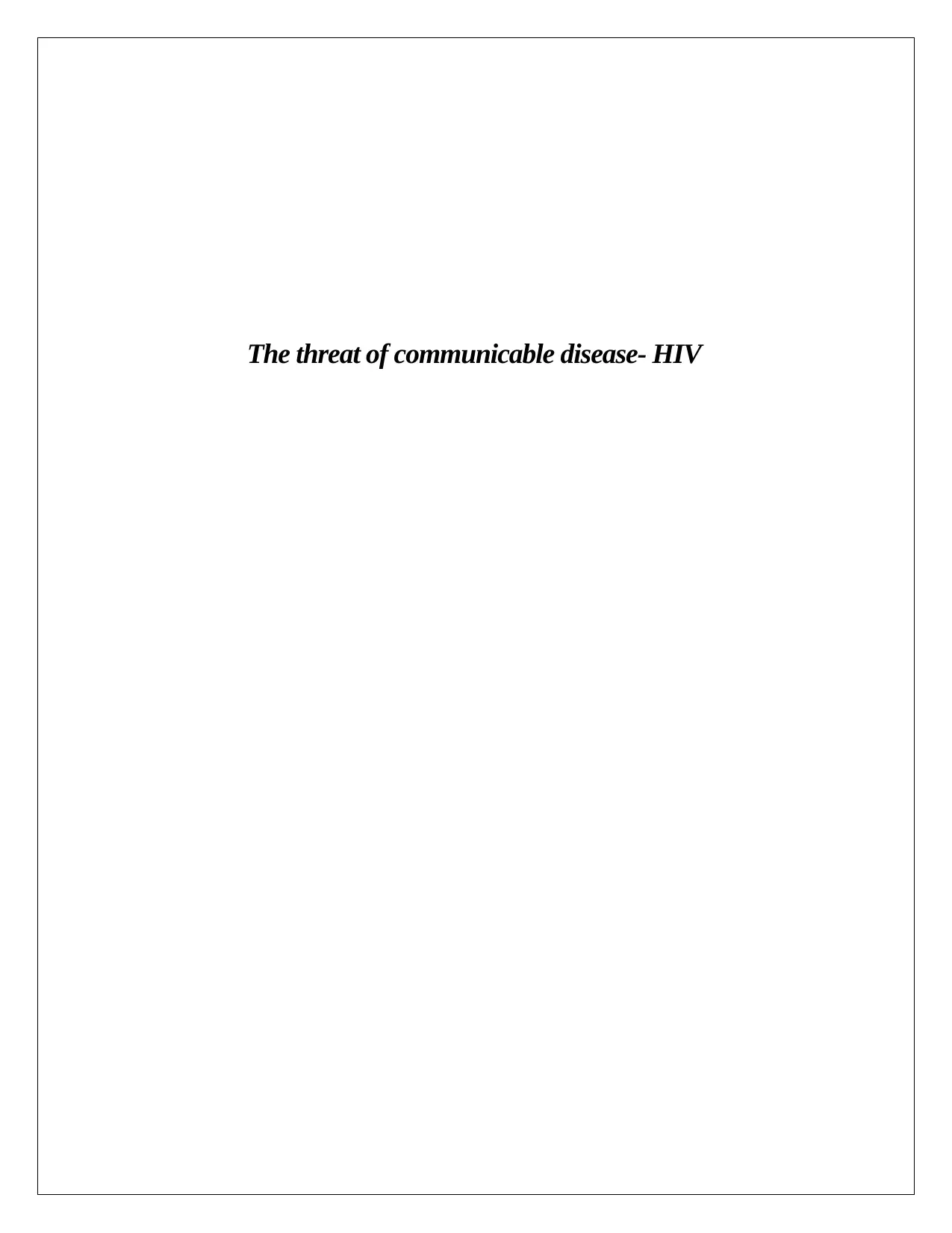
The threat of communicable disease- HIV
Paraphrase This Document
Need a fresh take? Get an instant paraphrase of this document with our AI Paraphraser
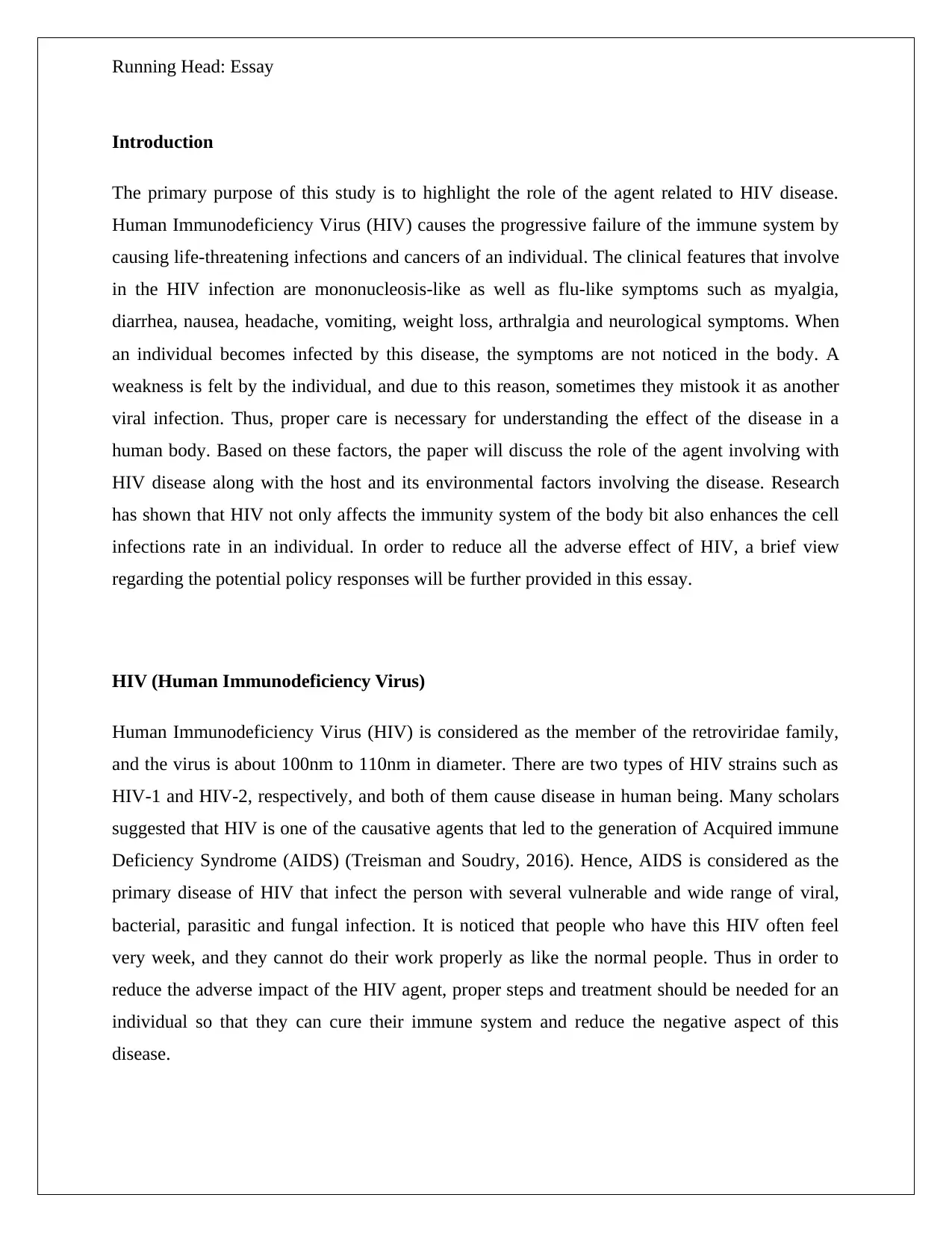
Running Head: Essay
Introduction
The primary purpose of this study is to highlight the role of the agent related to HIV disease.
Human Immunodeficiency Virus (HIV) causes the progressive failure of the immune system by
causing life-threatening infections and cancers of an individual. The clinical features that involve
in the HIV infection are mononucleosis-like as well as flu-like symptoms such as myalgia,
diarrhea, nausea, headache, vomiting, weight loss, arthralgia and neurological symptoms. When
an individual becomes infected by this disease, the symptoms are not noticed in the body. A
weakness is felt by the individual, and due to this reason, sometimes they mistook it as another
viral infection. Thus, proper care is necessary for understanding the effect of the disease in a
human body. Based on these factors, the paper will discuss the role of the agent involving with
HIV disease along with the host and its environmental factors involving the disease. Research
has shown that HIV not only affects the immunity system of the body bit also enhances the cell
infections rate in an individual. In order to reduce all the adverse effect of HIV, a brief view
regarding the potential policy responses will be further provided in this essay.
HIV (Human Immunodeficiency Virus)
Human Immunodeficiency Virus (HIV) is considered as the member of the retroviridae family,
and the virus is about 100nm to 110nm in diameter. There are two types of HIV strains such as
HIV-1 and HIV-2, respectively, and both of them cause disease in human being. Many scholars
suggested that HIV is one of the causative agents that led to the generation of Acquired immune
Deficiency Syndrome (AIDS) (Treisman and Soudry, 2016). Hence, AIDS is considered as the
primary disease of HIV that infect the person with several vulnerable and wide range of viral,
bacterial, parasitic and fungal infection. It is noticed that people who have this HIV often feel
very week, and they cannot do their work properly as like the normal people. Thus in order to
reduce the adverse impact of the HIV agent, proper steps and treatment should be needed for an
individual so that they can cure their immune system and reduce the negative aspect of this
disease.
Introduction
The primary purpose of this study is to highlight the role of the agent related to HIV disease.
Human Immunodeficiency Virus (HIV) causes the progressive failure of the immune system by
causing life-threatening infections and cancers of an individual. The clinical features that involve
in the HIV infection are mononucleosis-like as well as flu-like symptoms such as myalgia,
diarrhea, nausea, headache, vomiting, weight loss, arthralgia and neurological symptoms. When
an individual becomes infected by this disease, the symptoms are not noticed in the body. A
weakness is felt by the individual, and due to this reason, sometimes they mistook it as another
viral infection. Thus, proper care is necessary for understanding the effect of the disease in a
human body. Based on these factors, the paper will discuss the role of the agent involving with
HIV disease along with the host and its environmental factors involving the disease. Research
has shown that HIV not only affects the immunity system of the body bit also enhances the cell
infections rate in an individual. In order to reduce all the adverse effect of HIV, a brief view
regarding the potential policy responses will be further provided in this essay.
HIV (Human Immunodeficiency Virus)
Human Immunodeficiency Virus (HIV) is considered as the member of the retroviridae family,
and the virus is about 100nm to 110nm in diameter. There are two types of HIV strains such as
HIV-1 and HIV-2, respectively, and both of them cause disease in human being. Many scholars
suggested that HIV is one of the causative agents that led to the generation of Acquired immune
Deficiency Syndrome (AIDS) (Treisman and Soudry, 2016). Hence, AIDS is considered as the
primary disease of HIV that infect the person with several vulnerable and wide range of viral,
bacterial, parasitic and fungal infection. It is noticed that people who have this HIV often feel
very week, and they cannot do their work properly as like the normal people. Thus in order to
reduce the adverse impact of the HIV agent, proper steps and treatment should be needed for an
individual so that they can cure their immune system and reduce the negative aspect of this
disease.
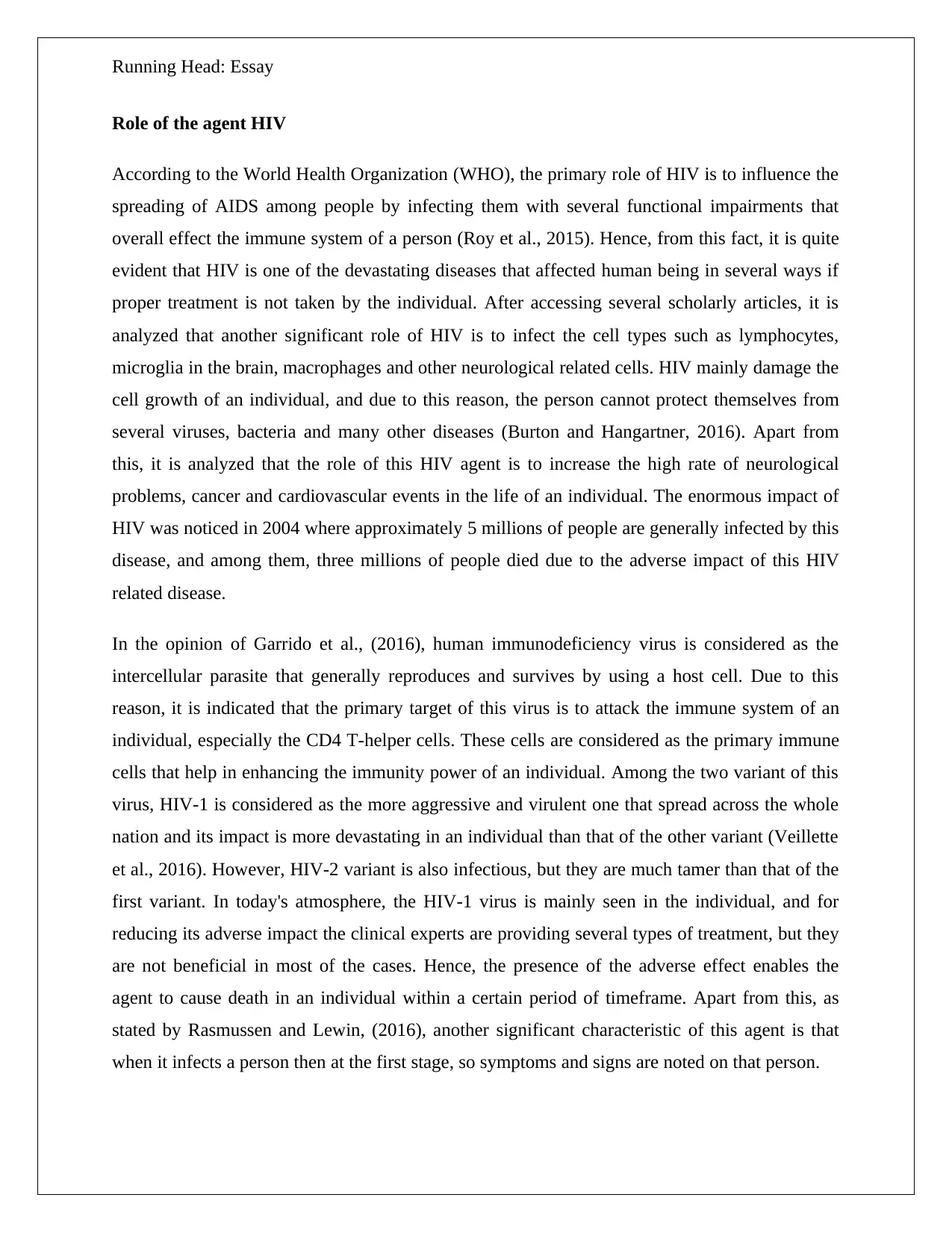
Running Head: Essay
Role of the agent HIV
According to the World Health Organization (WHO), the primary role of HIV is to influence the
spreading of AIDS among people by infecting them with several functional impairments that
overall effect the immune system of a person (Roy et al., 2015). Hence, from this fact, it is quite
evident that HIV is one of the devastating diseases that affected human being in several ways if
proper treatment is not taken by the individual. After accessing several scholarly articles, it is
analyzed that another significant role of HIV is to infect the cell types such as lymphocytes,
microglia in the brain, macrophages and other neurological related cells. HIV mainly damage the
cell growth of an individual, and due to this reason, the person cannot protect themselves from
several viruses, bacteria and many other diseases (Burton and Hangartner, 2016). Apart from
this, it is analyzed that the role of this HIV agent is to increase the high rate of neurological
problems, cancer and cardiovascular events in the life of an individual. The enormous impact of
HIV was noticed in 2004 where approximately 5 millions of people are generally infected by this
disease, and among them, three millions of people died due to the adverse impact of this HIV
related disease.
In the opinion of Garrido et al., (2016), human immunodeficiency virus is considered as the
intercellular parasite that generally reproduces and survives by using a host cell. Due to this
reason, it is indicated that the primary target of this virus is to attack the immune system of an
individual, especially the CD4 T-helper cells. These cells are considered as the primary immune
cells that help in enhancing the immunity power of an individual. Among the two variant of this
virus, HIV-1 is considered as the more aggressive and virulent one that spread across the whole
nation and its impact is more devastating in an individual than that of the other variant (Veillette
et al., 2016). However, HIV-2 variant is also infectious, but they are much tamer than that of the
first variant. In today's atmosphere, the HIV-1 virus is mainly seen in the individual, and for
reducing its adverse impact the clinical experts are providing several types of treatment, but they
are not beneficial in most of the cases. Hence, the presence of the adverse effect enables the
agent to cause death in an individual within a certain period of timeframe. Apart from this, as
stated by Rasmussen and Lewin, (2016), another significant characteristic of this agent is that
when it infects a person then at the first stage, so symptoms and signs are noted on that person.
Role of the agent HIV
According to the World Health Organization (WHO), the primary role of HIV is to influence the
spreading of AIDS among people by infecting them with several functional impairments that
overall effect the immune system of a person (Roy et al., 2015). Hence, from this fact, it is quite
evident that HIV is one of the devastating diseases that affected human being in several ways if
proper treatment is not taken by the individual. After accessing several scholarly articles, it is
analyzed that another significant role of HIV is to infect the cell types such as lymphocytes,
microglia in the brain, macrophages and other neurological related cells. HIV mainly damage the
cell growth of an individual, and due to this reason, the person cannot protect themselves from
several viruses, bacteria and many other diseases (Burton and Hangartner, 2016). Apart from
this, it is analyzed that the role of this HIV agent is to increase the high rate of neurological
problems, cancer and cardiovascular events in the life of an individual. The enormous impact of
HIV was noticed in 2004 where approximately 5 millions of people are generally infected by this
disease, and among them, three millions of people died due to the adverse impact of this HIV
related disease.
In the opinion of Garrido et al., (2016), human immunodeficiency virus is considered as the
intercellular parasite that generally reproduces and survives by using a host cell. Due to this
reason, it is indicated that the primary target of this virus is to attack the immune system of an
individual, especially the CD4 T-helper cells. These cells are considered as the primary immune
cells that help in enhancing the immunity power of an individual. Among the two variant of this
virus, HIV-1 is considered as the more aggressive and virulent one that spread across the whole
nation and its impact is more devastating in an individual than that of the other variant (Veillette
et al., 2016). However, HIV-2 variant is also infectious, but they are much tamer than that of the
first variant. In today's atmosphere, the HIV-1 virus is mainly seen in the individual, and for
reducing its adverse impact the clinical experts are providing several types of treatment, but they
are not beneficial in most of the cases. Hence, the presence of the adverse effect enables the
agent to cause death in an individual within a certain period of timeframe. Apart from this, as
stated by Rasmussen and Lewin, (2016), another significant characteristic of this agent is that
when it infects a person then at the first stage, so symptoms and signs are noted on that person.
⊘ This is a preview!⊘
Do you want full access?
Subscribe today to unlock all pages.

Trusted by 1+ million students worldwide
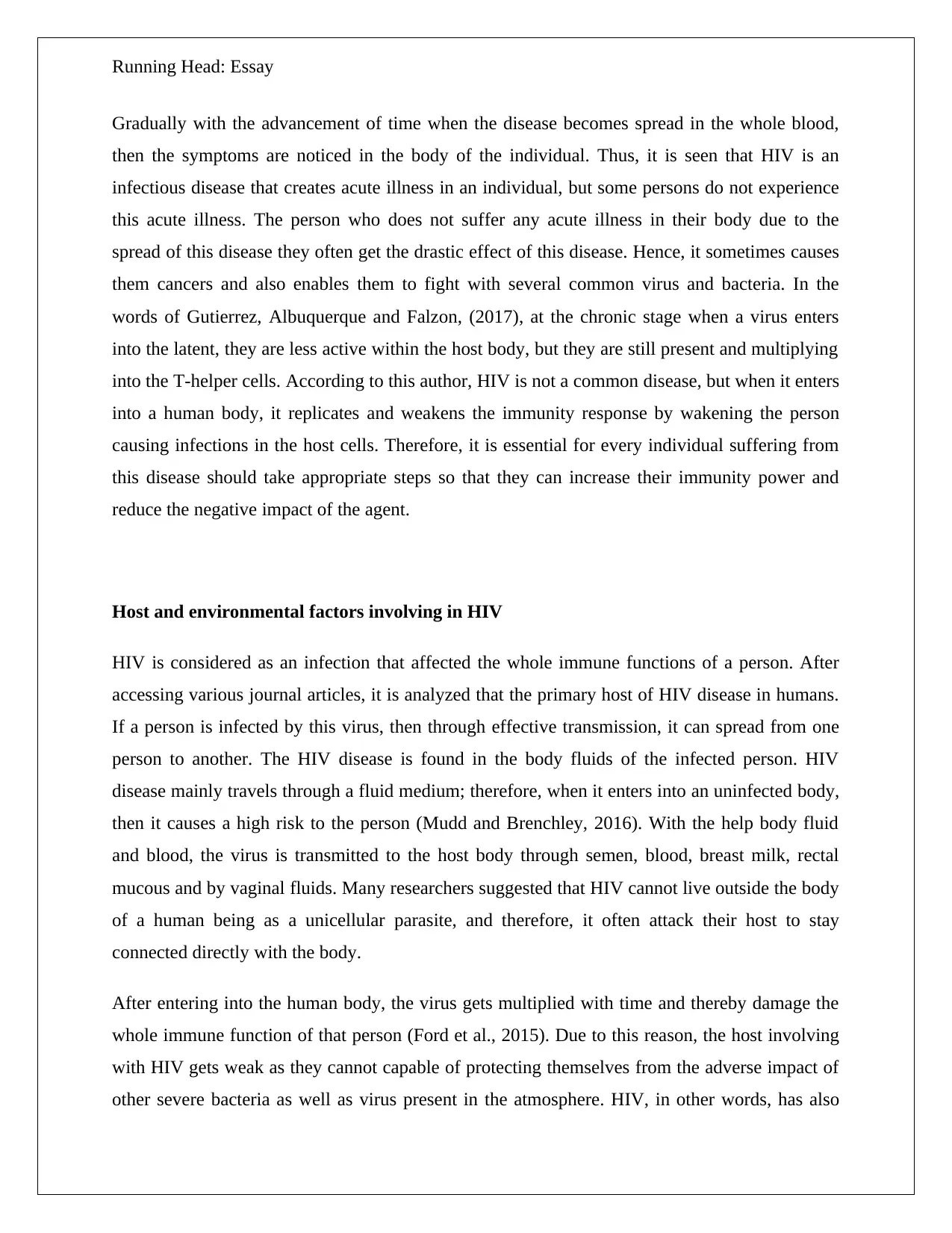
Running Head: Essay
Gradually with the advancement of time when the disease becomes spread in the whole blood,
then the symptoms are noticed in the body of the individual. Thus, it is seen that HIV is an
infectious disease that creates acute illness in an individual, but some persons do not experience
this acute illness. The person who does not suffer any acute illness in their body due to the
spread of this disease they often get the drastic effect of this disease. Hence, it sometimes causes
them cancers and also enables them to fight with several common virus and bacteria. In the
words of Gutierrez, Albuquerque and Falzon, (2017), at the chronic stage when a virus enters
into the latent, they are less active within the host body, but they are still present and multiplying
into the T-helper cells. According to this author, HIV is not a common disease, but when it enters
into a human body, it replicates and weakens the immunity response by wakening the person
causing infections in the host cells. Therefore, it is essential for every individual suffering from
this disease should take appropriate steps so that they can increase their immunity power and
reduce the negative impact of the agent.
Host and environmental factors involving in HIV
HIV is considered as an infection that affected the whole immune functions of a person. After
accessing various journal articles, it is analyzed that the primary host of HIV disease in humans.
If a person is infected by this virus, then through effective transmission, it can spread from one
person to another. The HIV disease is found in the body fluids of the infected person. HIV
disease mainly travels through a fluid medium; therefore, when it enters into an uninfected body,
then it causes a high risk to the person (Mudd and Brenchley, 2016). With the help body fluid
and blood, the virus is transmitted to the host body through semen, blood, breast milk, rectal
mucous and by vaginal fluids. Many researchers suggested that HIV cannot live outside the body
of a human being as a unicellular parasite, and therefore, it often attack their host to stay
connected directly with the body.
After entering into the human body, the virus gets multiplied with time and thereby damage the
whole immune function of that person (Ford et al., 2015). Due to this reason, the host involving
with HIV gets weak as they cannot capable of protecting themselves from the adverse impact of
other severe bacteria as well as virus present in the atmosphere. HIV, in other words, has also
Gradually with the advancement of time when the disease becomes spread in the whole blood,
then the symptoms are noticed in the body of the individual. Thus, it is seen that HIV is an
infectious disease that creates acute illness in an individual, but some persons do not experience
this acute illness. The person who does not suffer any acute illness in their body due to the
spread of this disease they often get the drastic effect of this disease. Hence, it sometimes causes
them cancers and also enables them to fight with several common virus and bacteria. In the
words of Gutierrez, Albuquerque and Falzon, (2017), at the chronic stage when a virus enters
into the latent, they are less active within the host body, but they are still present and multiplying
into the T-helper cells. According to this author, HIV is not a common disease, but when it enters
into a human body, it replicates and weakens the immunity response by wakening the person
causing infections in the host cells. Therefore, it is essential for every individual suffering from
this disease should take appropriate steps so that they can increase their immunity power and
reduce the negative impact of the agent.
Host and environmental factors involving in HIV
HIV is considered as an infection that affected the whole immune functions of a person. After
accessing various journal articles, it is analyzed that the primary host of HIV disease in humans.
If a person is infected by this virus, then through effective transmission, it can spread from one
person to another. The HIV disease is found in the body fluids of the infected person. HIV
disease mainly travels through a fluid medium; therefore, when it enters into an uninfected body,
then it causes a high risk to the person (Mudd and Brenchley, 2016). With the help body fluid
and blood, the virus is transmitted to the host body through semen, blood, breast milk, rectal
mucous and by vaginal fluids. Many researchers suggested that HIV cannot live outside the body
of a human being as a unicellular parasite, and therefore, it often attack their host to stay
connected directly with the body.
After entering into the human body, the virus gets multiplied with time and thereby damage the
whole immune function of that person (Ford et al., 2015). Due to this reason, the host involving
with HIV gets weak as they cannot capable of protecting themselves from the adverse impact of
other severe bacteria as well as virus present in the atmosphere. HIV, in other words, has also
Paraphrase This Document
Need a fresh take? Get an instant paraphrase of this document with our AI Paraphraser
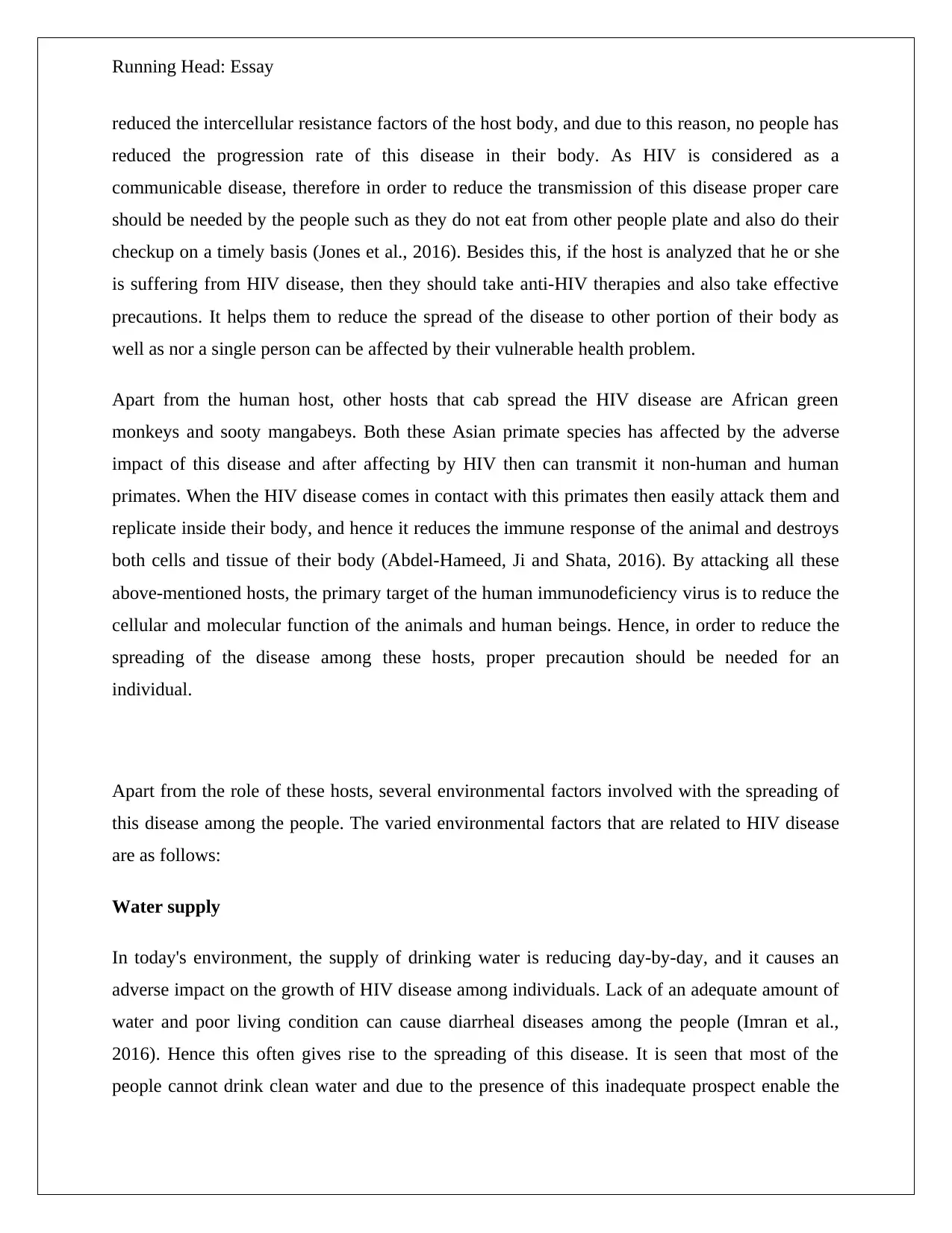
Running Head: Essay
reduced the intercellular resistance factors of the host body, and due to this reason, no people has
reduced the progression rate of this disease in their body. As HIV is considered as a
communicable disease, therefore in order to reduce the transmission of this disease proper care
should be needed by the people such as they do not eat from other people plate and also do their
checkup on a timely basis (Jones et al., 2016). Besides this, if the host is analyzed that he or she
is suffering from HIV disease, then they should take anti-HIV therapies and also take effective
precautions. It helps them to reduce the spread of the disease to other portion of their body as
well as nor a single person can be affected by their vulnerable health problem.
Apart from the human host, other hosts that cab spread the HIV disease are African green
monkeys and sooty mangabeys. Both these Asian primate species has affected by the adverse
impact of this disease and after affecting by HIV then can transmit it non-human and human
primates. When the HIV disease comes in contact with this primates then easily attack them and
replicate inside their body, and hence it reduces the immune response of the animal and destroys
both cells and tissue of their body (Abdel-Hameed, Ji and Shata, 2016). By attacking all these
above-mentioned hosts, the primary target of the human immunodeficiency virus is to reduce the
cellular and molecular function of the animals and human beings. Hence, in order to reduce the
spreading of the disease among these hosts, proper precaution should be needed for an
individual.
Apart from the role of these hosts, several environmental factors involved with the spreading of
this disease among the people. The varied environmental factors that are related to HIV disease
are as follows:
Water supply
In today's environment, the supply of drinking water is reducing day-by-day, and it causes an
adverse impact on the growth of HIV disease among individuals. Lack of an adequate amount of
water and poor living condition can cause diarrheal diseases among the people (Imran et al.,
2016). Hence this often gives rise to the spreading of this disease. It is seen that most of the
people cannot drink clean water and due to the presence of this inadequate prospect enable the
reduced the intercellular resistance factors of the host body, and due to this reason, no people has
reduced the progression rate of this disease in their body. As HIV is considered as a
communicable disease, therefore in order to reduce the transmission of this disease proper care
should be needed by the people such as they do not eat from other people plate and also do their
checkup on a timely basis (Jones et al., 2016). Besides this, if the host is analyzed that he or she
is suffering from HIV disease, then they should take anti-HIV therapies and also take effective
precautions. It helps them to reduce the spread of the disease to other portion of their body as
well as nor a single person can be affected by their vulnerable health problem.
Apart from the human host, other hosts that cab spread the HIV disease are African green
monkeys and sooty mangabeys. Both these Asian primate species has affected by the adverse
impact of this disease and after affecting by HIV then can transmit it non-human and human
primates. When the HIV disease comes in contact with this primates then easily attack them and
replicate inside their body, and hence it reduces the immune response of the animal and destroys
both cells and tissue of their body (Abdel-Hameed, Ji and Shata, 2016). By attacking all these
above-mentioned hosts, the primary target of the human immunodeficiency virus is to reduce the
cellular and molecular function of the animals and human beings. Hence, in order to reduce the
spreading of the disease among these hosts, proper precaution should be needed for an
individual.
Apart from the role of these hosts, several environmental factors involved with the spreading of
this disease among the people. The varied environmental factors that are related to HIV disease
are as follows:
Water supply
In today's environment, the supply of drinking water is reducing day-by-day, and it causes an
adverse impact on the growth of HIV disease among individuals. Lack of an adequate amount of
water and poor living condition can cause diarrheal diseases among the people (Imran et al.,
2016). Hence this often gives rise to the spreading of this disease. It is seen that most of the
people cannot drink clean water and due to the presence of this inadequate prospect enable the
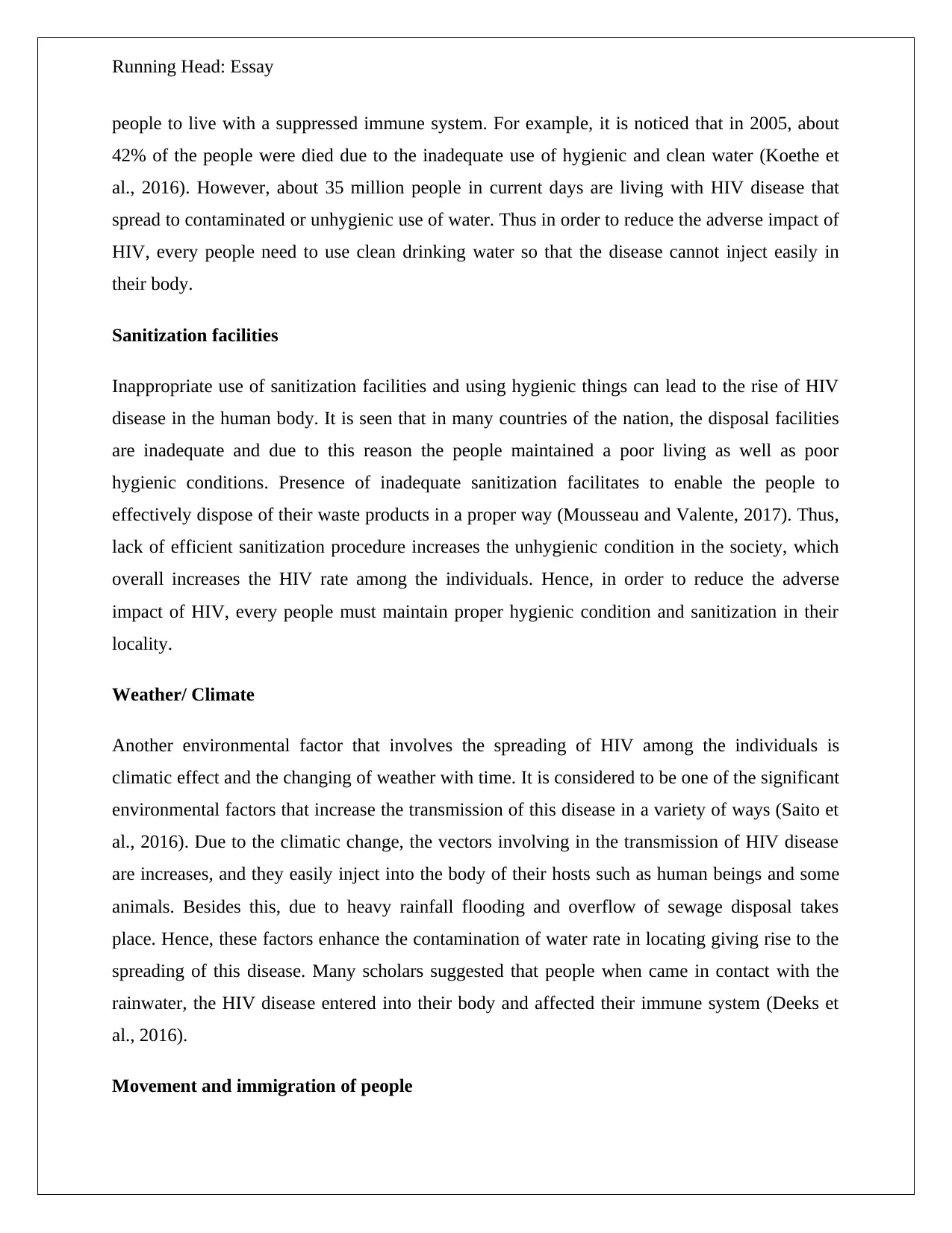
Running Head: Essay
people to live with a suppressed immune system. For example, it is noticed that in 2005, about
42% of the people were died due to the inadequate use of hygienic and clean water (Koethe et
al., 2016). However, about 35 million people in current days are living with HIV disease that
spread to contaminated or unhygienic use of water. Thus in order to reduce the adverse impact of
HIV, every people need to use clean drinking water so that the disease cannot inject easily in
their body.
Sanitization facilities
Inappropriate use of sanitization facilities and using hygienic things can lead to the rise of HIV
disease in the human body. It is seen that in many countries of the nation, the disposal facilities
are inadequate and due to this reason the people maintained a poor living as well as poor
hygienic conditions. Presence of inadequate sanitization facilitates to enable the people to
effectively dispose of their waste products in a proper way (Mousseau and Valente, 2017). Thus,
lack of efficient sanitization procedure increases the unhygienic condition in the society, which
overall increases the HIV rate among the individuals. Hence, in order to reduce the adverse
impact of HIV, every people must maintain proper hygienic condition and sanitization in their
locality.
Weather/ Climate
Another environmental factor that involves the spreading of HIV among the individuals is
climatic effect and the changing of weather with time. It is considered to be one of the significant
environmental factors that increase the transmission of this disease in a variety of ways (Saito et
al., 2016). Due to the climatic change, the vectors involving in the transmission of HIV disease
are increases, and they easily inject into the body of their hosts such as human beings and some
animals. Besides this, due to heavy rainfall flooding and overflow of sewage disposal takes
place. Hence, these factors enhance the contamination of water rate in locating giving rise to the
spreading of this disease. Many scholars suggested that people when came in contact with the
rainwater, the HIV disease entered into their body and affected their immune system (Deeks et
al., 2016).
Movement and immigration of people
people to live with a suppressed immune system. For example, it is noticed that in 2005, about
42% of the people were died due to the inadequate use of hygienic and clean water (Koethe et
al., 2016). However, about 35 million people in current days are living with HIV disease that
spread to contaminated or unhygienic use of water. Thus in order to reduce the adverse impact of
HIV, every people need to use clean drinking water so that the disease cannot inject easily in
their body.
Sanitization facilities
Inappropriate use of sanitization facilities and using hygienic things can lead to the rise of HIV
disease in the human body. It is seen that in many countries of the nation, the disposal facilities
are inadequate and due to this reason the people maintained a poor living as well as poor
hygienic conditions. Presence of inadequate sanitization facilitates to enable the people to
effectively dispose of their waste products in a proper way (Mousseau and Valente, 2017). Thus,
lack of efficient sanitization procedure increases the unhygienic condition in the society, which
overall increases the HIV rate among the individuals. Hence, in order to reduce the adverse
impact of HIV, every people must maintain proper hygienic condition and sanitization in their
locality.
Weather/ Climate
Another environmental factor that involves the spreading of HIV among the individuals is
climatic effect and the changing of weather with time. It is considered to be one of the significant
environmental factors that increase the transmission of this disease in a variety of ways (Saito et
al., 2016). Due to the climatic change, the vectors involving in the transmission of HIV disease
are increases, and they easily inject into the body of their hosts such as human beings and some
animals. Besides this, due to heavy rainfall flooding and overflow of sewage disposal takes
place. Hence, these factors enhance the contamination of water rate in locating giving rise to the
spreading of this disease. Many scholars suggested that people when came in contact with the
rainwater, the HIV disease entered into their body and affected their immune system (Deeks et
al., 2016).
Movement and immigration of people
⊘ This is a preview!⊘
Do you want full access?
Subscribe today to unlock all pages.

Trusted by 1+ million students worldwide
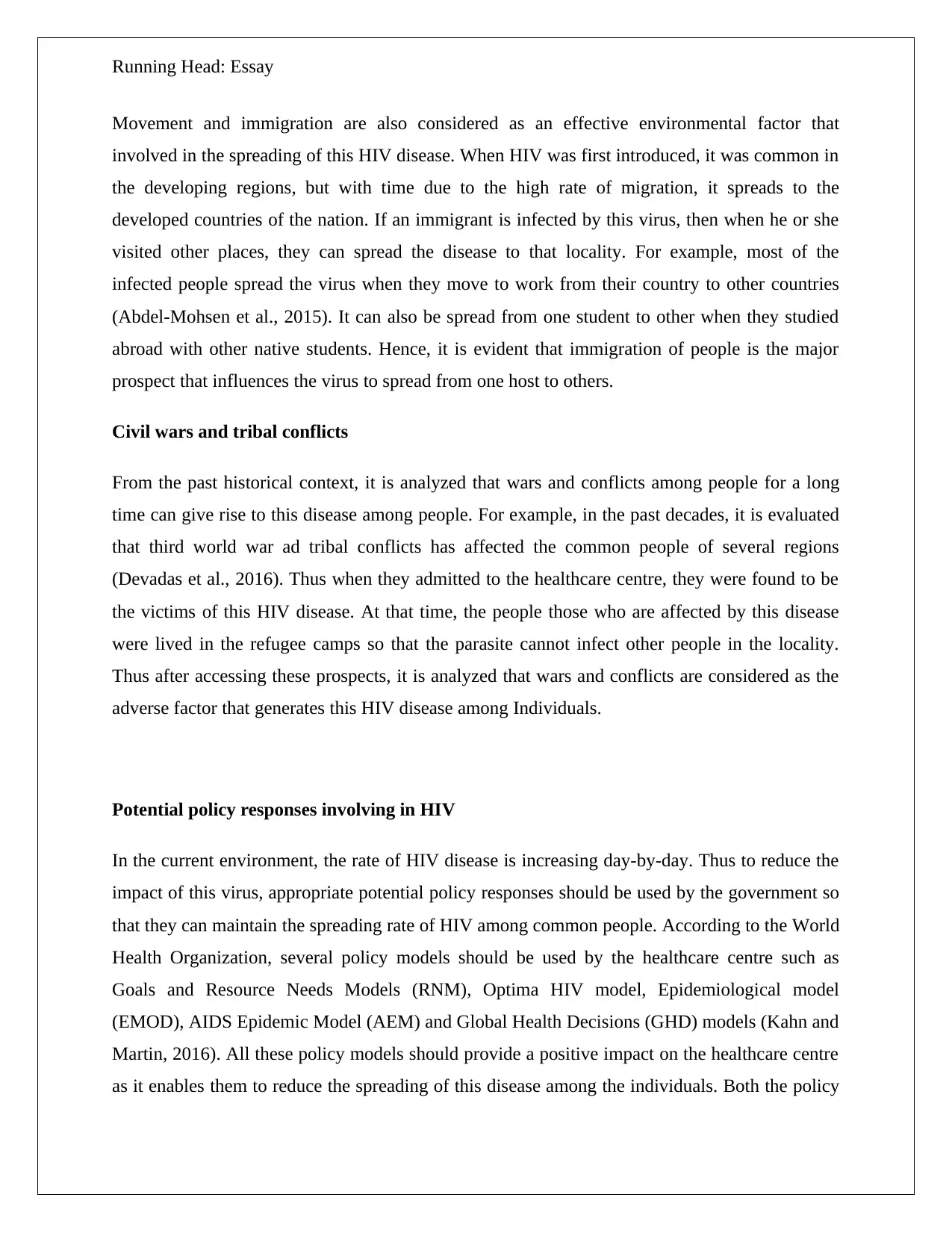
Running Head: Essay
Movement and immigration are also considered as an effective environmental factor that
involved in the spreading of this HIV disease. When HIV was first introduced, it was common in
the developing regions, but with time due to the high rate of migration, it spreads to the
developed countries of the nation. If an immigrant is infected by this virus, then when he or she
visited other places, they can spread the disease to that locality. For example, most of the
infected people spread the virus when they move to work from their country to other countries
(Abdel-Mohsen et al., 2015). It can also be spread from one student to other when they studied
abroad with other native students. Hence, it is evident that immigration of people is the major
prospect that influences the virus to spread from one host to others.
Civil wars and tribal conflicts
From the past historical context, it is analyzed that wars and conflicts among people for a long
time can give rise to this disease among people. For example, in the past decades, it is evaluated
that third world war ad tribal conflicts has affected the common people of several regions
(Devadas et al., 2016). Thus when they admitted to the healthcare centre, they were found to be
the victims of this HIV disease. At that time, the people those who are affected by this disease
were lived in the refugee camps so that the parasite cannot infect other people in the locality.
Thus after accessing these prospects, it is analyzed that wars and conflicts are considered as the
adverse factor that generates this HIV disease among Individuals.
Potential policy responses involving in HIV
In the current environment, the rate of HIV disease is increasing day-by-day. Thus to reduce the
impact of this virus, appropriate potential policy responses should be used by the government so
that they can maintain the spreading rate of HIV among common people. According to the World
Health Organization, several policy models should be used by the healthcare centre such as
Goals and Resource Needs Models (RNM), Optima HIV model, Epidemiological model
(EMOD), AIDS Epidemic Model (AEM) and Global Health Decisions (GHD) models (Kahn and
Martin, 2016). All these policy models should provide a positive impact on the healthcare centre
as it enables them to reduce the spreading of this disease among the individuals. Both the policy
Movement and immigration are also considered as an effective environmental factor that
involved in the spreading of this HIV disease. When HIV was first introduced, it was common in
the developing regions, but with time due to the high rate of migration, it spreads to the
developed countries of the nation. If an immigrant is infected by this virus, then when he or she
visited other places, they can spread the disease to that locality. For example, most of the
infected people spread the virus when they move to work from their country to other countries
(Abdel-Mohsen et al., 2015). It can also be spread from one student to other when they studied
abroad with other native students. Hence, it is evident that immigration of people is the major
prospect that influences the virus to spread from one host to others.
Civil wars and tribal conflicts
From the past historical context, it is analyzed that wars and conflicts among people for a long
time can give rise to this disease among people. For example, in the past decades, it is evaluated
that third world war ad tribal conflicts has affected the common people of several regions
(Devadas et al., 2016). Thus when they admitted to the healthcare centre, they were found to be
the victims of this HIV disease. At that time, the people those who are affected by this disease
were lived in the refugee camps so that the parasite cannot infect other people in the locality.
Thus after accessing these prospects, it is analyzed that wars and conflicts are considered as the
adverse factor that generates this HIV disease among Individuals.
Potential policy responses involving in HIV
In the current environment, the rate of HIV disease is increasing day-by-day. Thus to reduce the
impact of this virus, appropriate potential policy responses should be used by the government so
that they can maintain the spreading rate of HIV among common people. According to the World
Health Organization, several policy models should be used by the healthcare centre such as
Goals and Resource Needs Models (RNM), Optima HIV model, Epidemiological model
(EMOD), AIDS Epidemic Model (AEM) and Global Health Decisions (GHD) models (Kahn and
Martin, 2016). All these policy models should provide a positive impact on the healthcare centre
as it enables them to reduce the spreading of this disease among the individuals. Both the policy
Paraphrase This Document
Need a fresh take? Get an instant paraphrase of this document with our AI Paraphraser
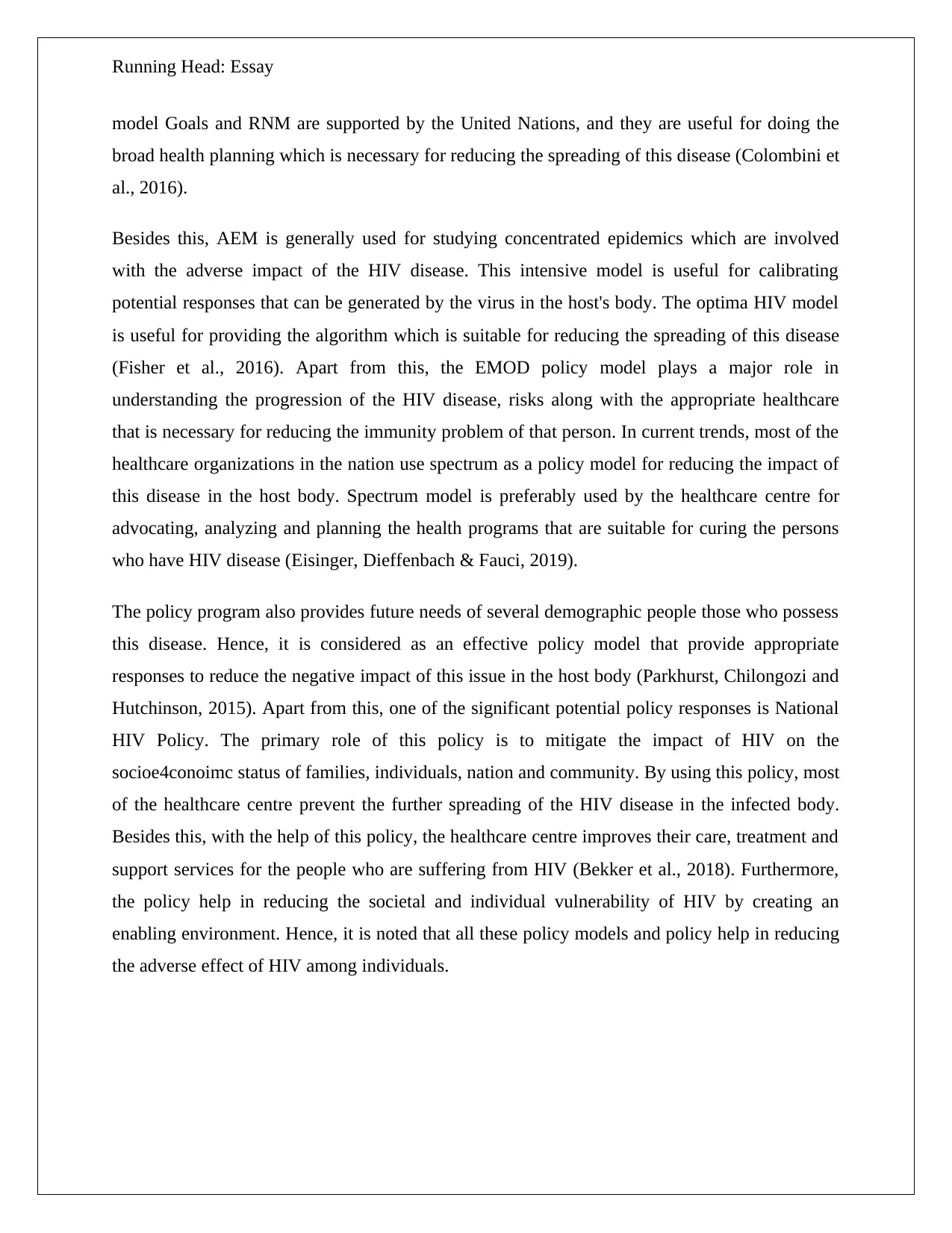
Running Head: Essay
model Goals and RNM are supported by the United Nations, and they are useful for doing the
broad health planning which is necessary for reducing the spreading of this disease (Colombini et
al., 2016).
Besides this, AEM is generally used for studying concentrated epidemics which are involved
with the adverse impact of the HIV disease. This intensive model is useful for calibrating
potential responses that can be generated by the virus in the host's body. The optima HIV model
is useful for providing the algorithm which is suitable for reducing the spreading of this disease
(Fisher et al., 2016). Apart from this, the EMOD policy model plays a major role in
understanding the progression of the HIV disease, risks along with the appropriate healthcare
that is necessary for reducing the immunity problem of that person. In current trends, most of the
healthcare organizations in the nation use spectrum as a policy model for reducing the impact of
this disease in the host body. Spectrum model is preferably used by the healthcare centre for
advocating, analyzing and planning the health programs that are suitable for curing the persons
who have HIV disease (Eisinger, Dieffenbach & Fauci, 2019).
The policy program also provides future needs of several demographic people those who possess
this disease. Hence, it is considered as an effective policy model that provide appropriate
responses to reduce the negative impact of this issue in the host body (Parkhurst, Chilongozi and
Hutchinson, 2015). Apart from this, one of the significant potential policy responses is National
HIV Policy. The primary role of this policy is to mitigate the impact of HIV on the
socioe4conoimc status of families, individuals, nation and community. By using this policy, most
of the healthcare centre prevent the further spreading of the HIV disease in the infected body.
Besides this, with the help of this policy, the healthcare centre improves their care, treatment and
support services for the people who are suffering from HIV (Bekker et al., 2018). Furthermore,
the policy help in reducing the societal and individual vulnerability of HIV by creating an
enabling environment. Hence, it is noted that all these policy models and policy help in reducing
the adverse effect of HIV among individuals.
model Goals and RNM are supported by the United Nations, and they are useful for doing the
broad health planning which is necessary for reducing the spreading of this disease (Colombini et
al., 2016).
Besides this, AEM is generally used for studying concentrated epidemics which are involved
with the adverse impact of the HIV disease. This intensive model is useful for calibrating
potential responses that can be generated by the virus in the host's body. The optima HIV model
is useful for providing the algorithm which is suitable for reducing the spreading of this disease
(Fisher et al., 2016). Apart from this, the EMOD policy model plays a major role in
understanding the progression of the HIV disease, risks along with the appropriate healthcare
that is necessary for reducing the immunity problem of that person. In current trends, most of the
healthcare organizations in the nation use spectrum as a policy model for reducing the impact of
this disease in the host body. Spectrum model is preferably used by the healthcare centre for
advocating, analyzing and planning the health programs that are suitable for curing the persons
who have HIV disease (Eisinger, Dieffenbach & Fauci, 2019).
The policy program also provides future needs of several demographic people those who possess
this disease. Hence, it is considered as an effective policy model that provide appropriate
responses to reduce the negative impact of this issue in the host body (Parkhurst, Chilongozi and
Hutchinson, 2015). Apart from this, one of the significant potential policy responses is National
HIV Policy. The primary role of this policy is to mitigate the impact of HIV on the
socioe4conoimc status of families, individuals, nation and community. By using this policy, most
of the healthcare centre prevent the further spreading of the HIV disease in the infected body.
Besides this, with the help of this policy, the healthcare centre improves their care, treatment and
support services for the people who are suffering from HIV (Bekker et al., 2018). Furthermore,
the policy help in reducing the societal and individual vulnerability of HIV by creating an
enabling environment. Hence, it is noted that all these policy models and policy help in reducing
the adverse effect of HIV among individuals.
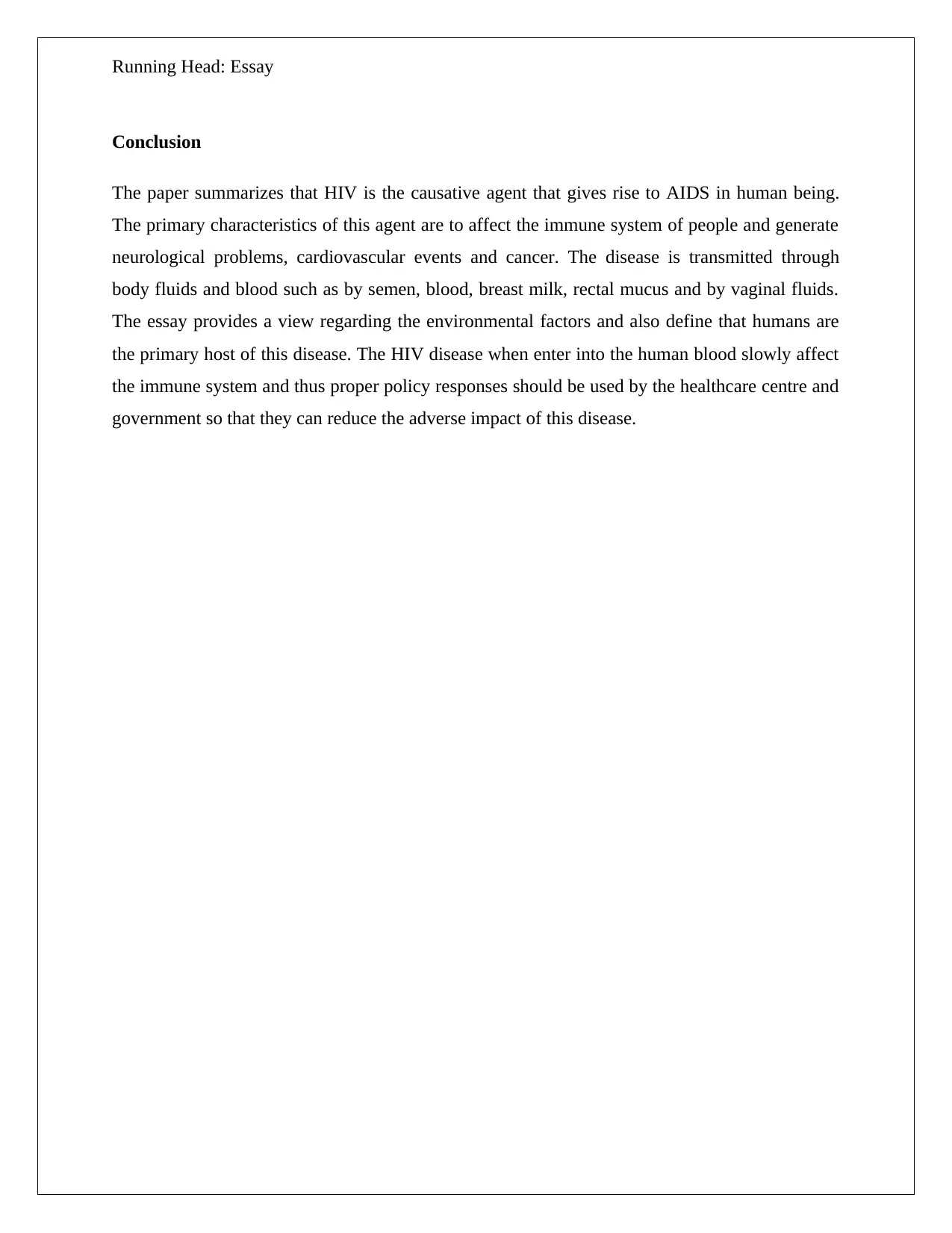
Running Head: Essay
Conclusion
The paper summarizes that HIV is the causative agent that gives rise to AIDS in human being.
The primary characteristics of this agent are to affect the immune system of people and generate
neurological problems, cardiovascular events and cancer. The disease is transmitted through
body fluids and blood such as by semen, blood, breast milk, rectal mucus and by vaginal fluids.
The essay provides a view regarding the environmental factors and also define that humans are
the primary host of this disease. The HIV disease when enter into the human blood slowly affect
the immune system and thus proper policy responses should be used by the healthcare centre and
government so that they can reduce the adverse impact of this disease.
Conclusion
The paper summarizes that HIV is the causative agent that gives rise to AIDS in human being.
The primary characteristics of this agent are to affect the immune system of people and generate
neurological problems, cardiovascular events and cancer. The disease is transmitted through
body fluids and blood such as by semen, blood, breast milk, rectal mucus and by vaginal fluids.
The essay provides a view regarding the environmental factors and also define that humans are
the primary host of this disease. The HIV disease when enter into the human blood slowly affect
the immune system and thus proper policy responses should be used by the healthcare centre and
government so that they can reduce the adverse impact of this disease.
⊘ This is a preview!⊘
Do you want full access?
Subscribe today to unlock all pages.

Trusted by 1+ million students worldwide
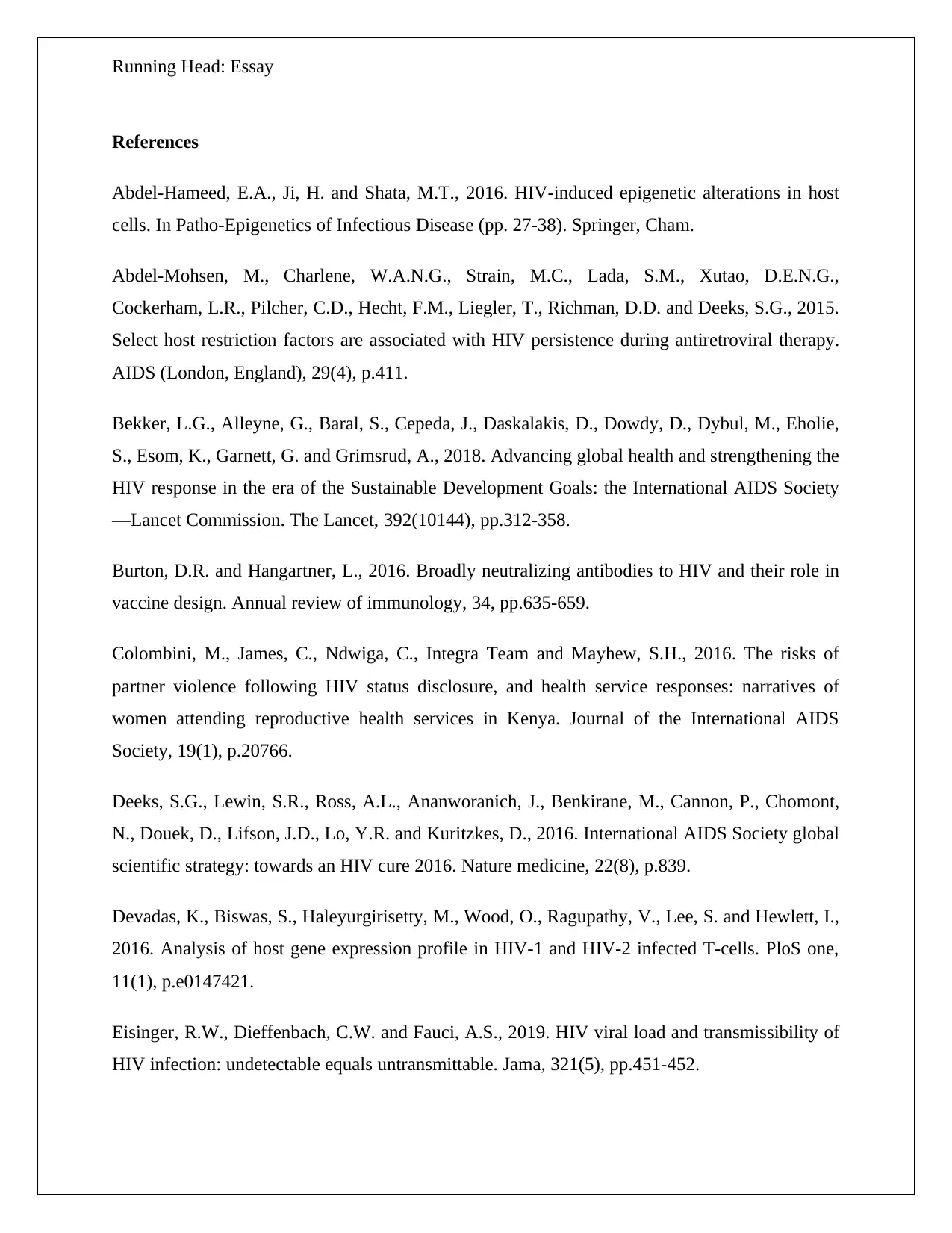
Running Head: Essay
References
Abdel-Hameed, E.A., Ji, H. and Shata, M.T., 2016. HIV-induced epigenetic alterations in host
cells. In Patho-Epigenetics of Infectious Disease (pp. 27-38). Springer, Cham.
Abdel-Mohsen, M., Charlene, W.A.N.G., Strain, M.C., Lada, S.M., Xutao, D.E.N.G.,
Cockerham, L.R., Pilcher, C.D., Hecht, F.M., Liegler, T., Richman, D.D. and Deeks, S.G., 2015.
Select host restriction factors are associated with HIV persistence during antiretroviral therapy.
AIDS (London, England), 29(4), p.411.
Bekker, L.G., Alleyne, G., Baral, S., Cepeda, J., Daskalakis, D., Dowdy, D., Dybul, M., Eholie,
S., Esom, K., Garnett, G. and Grimsrud, A., 2018. Advancing global health and strengthening the
HIV response in the era of the Sustainable Development Goals: the International AIDS Society
—Lancet Commission. The Lancet, 392(10144), pp.312-358.
Burton, D.R. and Hangartner, L., 2016. Broadly neutralizing antibodies to HIV and their role in
vaccine design. Annual review of immunology, 34, pp.635-659.
Colombini, M., James, C., Ndwiga, C., Integra Team and Mayhew, S.H., 2016. The risks of
partner violence following HIV status disclosure, and health service responses: narratives of
women attending reproductive health services in Kenya. Journal of the International AIDS
Society, 19(1), p.20766.
Deeks, S.G., Lewin, S.R., Ross, A.L., Ananworanich, J., Benkirane, M., Cannon, P., Chomont,
N., Douek, D., Lifson, J.D., Lo, Y.R. and Kuritzkes, D., 2016. International AIDS Society global
scientific strategy: towards an HIV cure 2016. Nature medicine, 22(8), p.839.
Devadas, K., Biswas, S., Haleyurgirisetty, M., Wood, O., Ragupathy, V., Lee, S. and Hewlett, I.,
2016. Analysis of host gene expression profile in HIV-1 and HIV-2 infected T-cells. PloS one,
11(1), p.e0147421.
Eisinger, R.W., Dieffenbach, C.W. and Fauci, A.S., 2019. HIV viral load and transmissibility of
HIV infection: undetectable equals untransmittable. Jama, 321(5), pp.451-452.
References
Abdel-Hameed, E.A., Ji, H. and Shata, M.T., 2016. HIV-induced epigenetic alterations in host
cells. In Patho-Epigenetics of Infectious Disease (pp. 27-38). Springer, Cham.
Abdel-Mohsen, M., Charlene, W.A.N.G., Strain, M.C., Lada, S.M., Xutao, D.E.N.G.,
Cockerham, L.R., Pilcher, C.D., Hecht, F.M., Liegler, T., Richman, D.D. and Deeks, S.G., 2015.
Select host restriction factors are associated with HIV persistence during antiretroviral therapy.
AIDS (London, England), 29(4), p.411.
Bekker, L.G., Alleyne, G., Baral, S., Cepeda, J., Daskalakis, D., Dowdy, D., Dybul, M., Eholie,
S., Esom, K., Garnett, G. and Grimsrud, A., 2018. Advancing global health and strengthening the
HIV response in the era of the Sustainable Development Goals: the International AIDS Society
—Lancet Commission. The Lancet, 392(10144), pp.312-358.
Burton, D.R. and Hangartner, L., 2016. Broadly neutralizing antibodies to HIV and their role in
vaccine design. Annual review of immunology, 34, pp.635-659.
Colombini, M., James, C., Ndwiga, C., Integra Team and Mayhew, S.H., 2016. The risks of
partner violence following HIV status disclosure, and health service responses: narratives of
women attending reproductive health services in Kenya. Journal of the International AIDS
Society, 19(1), p.20766.
Deeks, S.G., Lewin, S.R., Ross, A.L., Ananworanich, J., Benkirane, M., Cannon, P., Chomont,
N., Douek, D., Lifson, J.D., Lo, Y.R. and Kuritzkes, D., 2016. International AIDS Society global
scientific strategy: towards an HIV cure 2016. Nature medicine, 22(8), p.839.
Devadas, K., Biswas, S., Haleyurgirisetty, M., Wood, O., Ragupathy, V., Lee, S. and Hewlett, I.,
2016. Analysis of host gene expression profile in HIV-1 and HIV-2 infected T-cells. PloS one,
11(1), p.e0147421.
Eisinger, R.W., Dieffenbach, C.W. and Fauci, A.S., 2019. HIV viral load and transmissibility of
HIV infection: undetectable equals untransmittable. Jama, 321(5), pp.451-452.
Paraphrase This Document
Need a fresh take? Get an instant paraphrase of this document with our AI Paraphraser
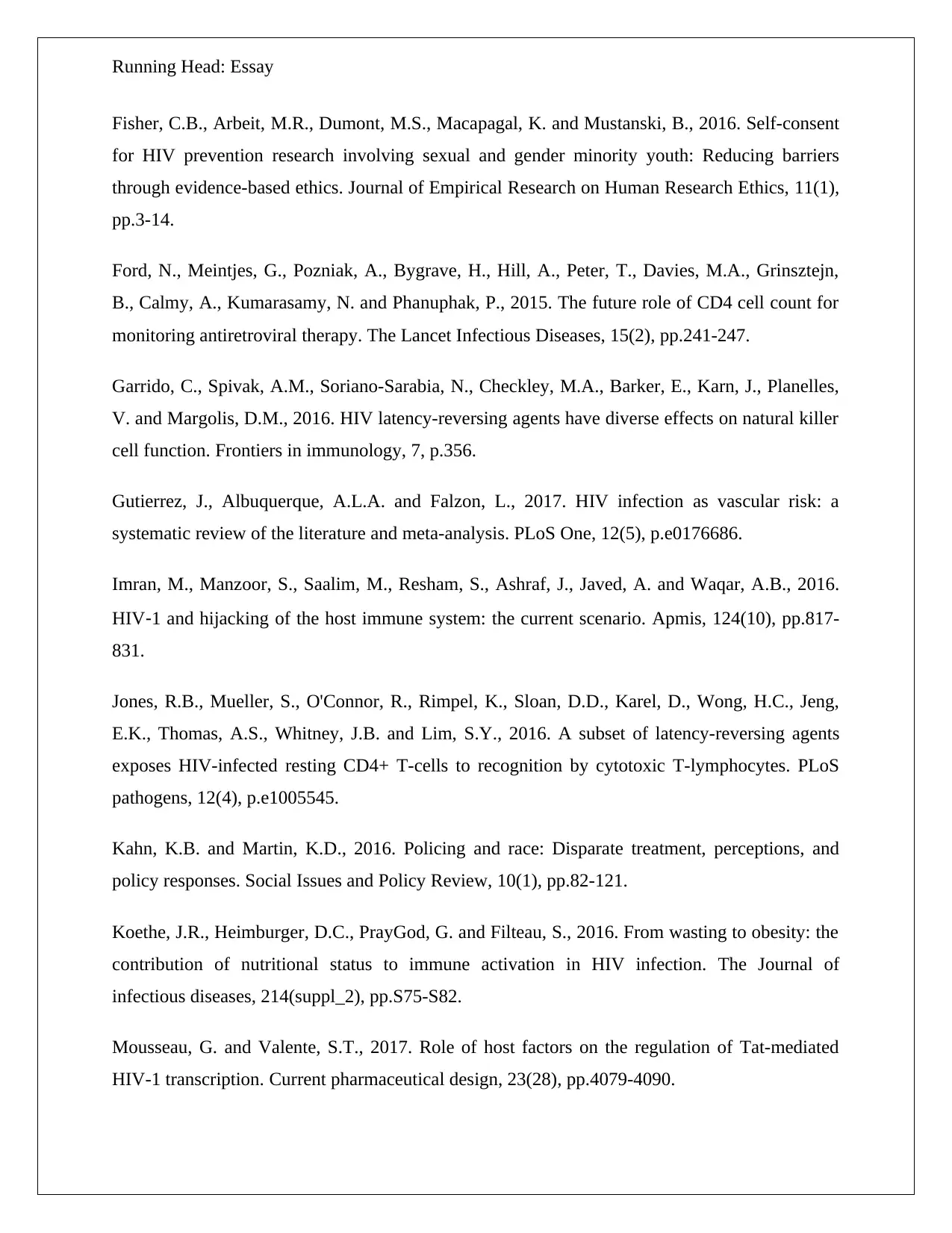
Running Head: Essay
Fisher, C.B., Arbeit, M.R., Dumont, M.S., Macapagal, K. and Mustanski, B., 2016. Self-consent
for HIV prevention research involving sexual and gender minority youth: Reducing barriers
through evidence-based ethics. Journal of Empirical Research on Human Research Ethics, 11(1),
pp.3-14.
Ford, N., Meintjes, G., Pozniak, A., Bygrave, H., Hill, A., Peter, T., Davies, M.A., Grinsztejn,
B., Calmy, A., Kumarasamy, N. and Phanuphak, P., 2015. The future role of CD4 cell count for
monitoring antiretroviral therapy. The Lancet Infectious Diseases, 15(2), pp.241-247.
Garrido, C., Spivak, A.M., Soriano-Sarabia, N., Checkley, M.A., Barker, E., Karn, J., Planelles,
V. and Margolis, D.M., 2016. HIV latency-reversing agents have diverse effects on natural killer
cell function. Frontiers in immunology, 7, p.356.
Gutierrez, J., Albuquerque, A.L.A. and Falzon, L., 2017. HIV infection as vascular risk: a
systematic review of the literature and meta-analysis. PLoS One, 12(5), p.e0176686.
Imran, M., Manzoor, S., Saalim, M., Resham, S., Ashraf, J., Javed, A. and Waqar, A.B., 2016.
HIV‐1 and hijacking of the host immune system: the current scenario. Apmis, 124(10), pp.817-
831.
Jones, R.B., Mueller, S., O'Connor, R., Rimpel, K., Sloan, D.D., Karel, D., Wong, H.C., Jeng,
E.K., Thomas, A.S., Whitney, J.B. and Lim, S.Y., 2016. A subset of latency-reversing agents
exposes HIV-infected resting CD4+ T-cells to recognition by cytotoxic T-lymphocytes. PLoS
pathogens, 12(4), p.e1005545.
Kahn, K.B. and Martin, K.D., 2016. Policing and race: Disparate treatment, perceptions, and
policy responses. Social Issues and Policy Review, 10(1), pp.82-121.
Koethe, J.R., Heimburger, D.C., PrayGod, G. and Filteau, S., 2016. From wasting to obesity: the
contribution of nutritional status to immune activation in HIV infection. The Journal of
infectious diseases, 214(suppl_2), pp.S75-S82.
Mousseau, G. and Valente, S.T., 2017. Role of host factors on the regulation of Tat-mediated
HIV-1 transcription. Current pharmaceutical design, 23(28), pp.4079-4090.
Fisher, C.B., Arbeit, M.R., Dumont, M.S., Macapagal, K. and Mustanski, B., 2016. Self-consent
for HIV prevention research involving sexual and gender minority youth: Reducing barriers
through evidence-based ethics. Journal of Empirical Research on Human Research Ethics, 11(1),
pp.3-14.
Ford, N., Meintjes, G., Pozniak, A., Bygrave, H., Hill, A., Peter, T., Davies, M.A., Grinsztejn,
B., Calmy, A., Kumarasamy, N. and Phanuphak, P., 2015. The future role of CD4 cell count for
monitoring antiretroviral therapy. The Lancet Infectious Diseases, 15(2), pp.241-247.
Garrido, C., Spivak, A.M., Soriano-Sarabia, N., Checkley, M.A., Barker, E., Karn, J., Planelles,
V. and Margolis, D.M., 2016. HIV latency-reversing agents have diverse effects on natural killer
cell function. Frontiers in immunology, 7, p.356.
Gutierrez, J., Albuquerque, A.L.A. and Falzon, L., 2017. HIV infection as vascular risk: a
systematic review of the literature and meta-analysis. PLoS One, 12(5), p.e0176686.
Imran, M., Manzoor, S., Saalim, M., Resham, S., Ashraf, J., Javed, A. and Waqar, A.B., 2016.
HIV‐1 and hijacking of the host immune system: the current scenario. Apmis, 124(10), pp.817-
831.
Jones, R.B., Mueller, S., O'Connor, R., Rimpel, K., Sloan, D.D., Karel, D., Wong, H.C., Jeng,
E.K., Thomas, A.S., Whitney, J.B. and Lim, S.Y., 2016. A subset of latency-reversing agents
exposes HIV-infected resting CD4+ T-cells to recognition by cytotoxic T-lymphocytes. PLoS
pathogens, 12(4), p.e1005545.
Kahn, K.B. and Martin, K.D., 2016. Policing and race: Disparate treatment, perceptions, and
policy responses. Social Issues and Policy Review, 10(1), pp.82-121.
Koethe, J.R., Heimburger, D.C., PrayGod, G. and Filteau, S., 2016. From wasting to obesity: the
contribution of nutritional status to immune activation in HIV infection. The Journal of
infectious diseases, 214(suppl_2), pp.S75-S82.
Mousseau, G. and Valente, S.T., 2017. Role of host factors on the regulation of Tat-mediated
HIV-1 transcription. Current pharmaceutical design, 23(28), pp.4079-4090.
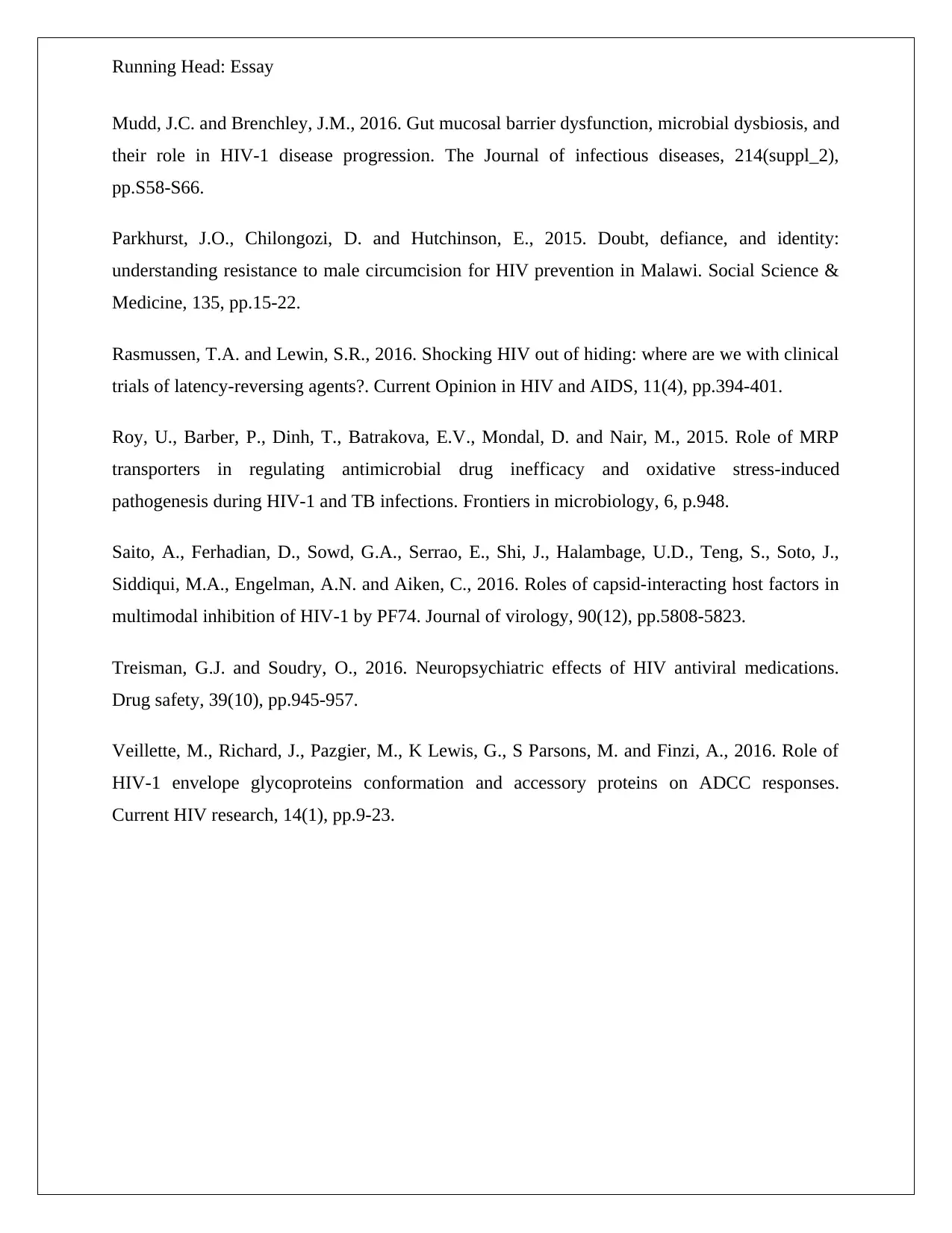
Running Head: Essay
Mudd, J.C. and Brenchley, J.M., 2016. Gut mucosal barrier dysfunction, microbial dysbiosis, and
their role in HIV-1 disease progression. The Journal of infectious diseases, 214(suppl_2),
pp.S58-S66.
Parkhurst, J.O., Chilongozi, D. and Hutchinson, E., 2015. Doubt, defiance, and identity:
understanding resistance to male circumcision for HIV prevention in Malawi. Social Science &
Medicine, 135, pp.15-22.
Rasmussen, T.A. and Lewin, S.R., 2016. Shocking HIV out of hiding: where are we with clinical
trials of latency-reversing agents?. Current Opinion in HIV and AIDS, 11(4), pp.394-401.
Roy, U., Barber, P., Dinh, T., Batrakova, E.V., Mondal, D. and Nair, M., 2015. Role of MRP
transporters in regulating antimicrobial drug inefficacy and oxidative stress-induced
pathogenesis during HIV-1 and TB infections. Frontiers in microbiology, 6, p.948.
Saito, A., Ferhadian, D., Sowd, G.A., Serrao, E., Shi, J., Halambage, U.D., Teng, S., Soto, J.,
Siddiqui, M.A., Engelman, A.N. and Aiken, C., 2016. Roles of capsid-interacting host factors in
multimodal inhibition of HIV-1 by PF74. Journal of virology, 90(12), pp.5808-5823.
Treisman, G.J. and Soudry, O., 2016. Neuropsychiatric effects of HIV antiviral medications.
Drug safety, 39(10), pp.945-957.
Veillette, M., Richard, J., Pazgier, M., K Lewis, G., S Parsons, M. and Finzi, A., 2016. Role of
HIV-1 envelope glycoproteins conformation and accessory proteins on ADCC responses.
Current HIV research, 14(1), pp.9-23.
Mudd, J.C. and Brenchley, J.M., 2016. Gut mucosal barrier dysfunction, microbial dysbiosis, and
their role in HIV-1 disease progression. The Journal of infectious diseases, 214(suppl_2),
pp.S58-S66.
Parkhurst, J.O., Chilongozi, D. and Hutchinson, E., 2015. Doubt, defiance, and identity:
understanding resistance to male circumcision for HIV prevention in Malawi. Social Science &
Medicine, 135, pp.15-22.
Rasmussen, T.A. and Lewin, S.R., 2016. Shocking HIV out of hiding: where are we with clinical
trials of latency-reversing agents?. Current Opinion in HIV and AIDS, 11(4), pp.394-401.
Roy, U., Barber, P., Dinh, T., Batrakova, E.V., Mondal, D. and Nair, M., 2015. Role of MRP
transporters in regulating antimicrobial drug inefficacy and oxidative stress-induced
pathogenesis during HIV-1 and TB infections. Frontiers in microbiology, 6, p.948.
Saito, A., Ferhadian, D., Sowd, G.A., Serrao, E., Shi, J., Halambage, U.D., Teng, S., Soto, J.,
Siddiqui, M.A., Engelman, A.N. and Aiken, C., 2016. Roles of capsid-interacting host factors in
multimodal inhibition of HIV-1 by PF74. Journal of virology, 90(12), pp.5808-5823.
Treisman, G.J. and Soudry, O., 2016. Neuropsychiatric effects of HIV antiviral medications.
Drug safety, 39(10), pp.945-957.
Veillette, M., Richard, J., Pazgier, M., K Lewis, G., S Parsons, M. and Finzi, A., 2016. Role of
HIV-1 envelope glycoproteins conformation and accessory proteins on ADCC responses.
Current HIV research, 14(1), pp.9-23.
⊘ This is a preview!⊘
Do you want full access?
Subscribe today to unlock all pages.

Trusted by 1+ million students worldwide
1 out of 12
Related Documents
Your All-in-One AI-Powered Toolkit for Academic Success.
+13062052269
info@desklib.com
Available 24*7 on WhatsApp / Email
![[object Object]](/_next/static/media/star-bottom.7253800d.svg)
Unlock your academic potential
Copyright © 2020–2025 A2Z Services. All Rights Reserved. Developed and managed by ZUCOL.





